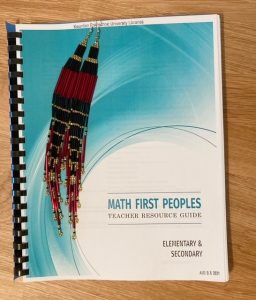21 Math First Peoples Indigenous Resource Guide
Hanna Erceg and Zack Russel
Contributors’s Biographies:
Hanna Erceg is a third-year Arts student studying to get a Bachelors if Arts with a major in Psychology, a minor in Counselling, as well as an Education Stream Certificate. Hanna aspires to be a Clinical Psychologist. Outside of school, they enjoy reading, watching movies, and eating pasta.
Zack Russel, another contributor, did not provide a biography.
Resource Overview
Web Link-PDF Document:
First Nations Education Steering Committee. (2020). Math First Peoples: A teacher resource guide. http://www.fnesc.ca/wp/wp-content/uploads/2020/09/PUBLICATION-Math-FP-TRG-2020-09-04.pdf
Grade Level: Grades kindergarten to twelve
Description:
The Math First Peoples is a resource guide intended for mathematics instructors in British Columbia at the Elementary and Secondary levels (First Nations Education Steering Committee [FNESC], 2020). The document allows individuals to approach mathematics with a different perspective and learn more about the role Indigenous Knowledges and cultures can play in a mathematical context (FNESC, 2020). The publication emphasizes this understanding through the use of Indigenous stories, demonstrations of practices, songs, and traditions. This guide is a resource that allows educators to integrate First Peoples Knowledges in a respectful way and recognizes that few educators have a full understanding of Indigenous cultures and traditions (FNESC, 2020). Through the use of this guide, both participants and educators gain a deeper intercultural understanding.
Significant Indigenous Knowledge:
The Math First Peoples resource guide incorporates several significant Indigenous Knowledges, practices, perspectives, and content into lesson plans. It focuses heavily on interconnectedness, teaching individuals to recognize the relationship between each other as well as nature. Further, it teaches the foundations of the concepts of place and land-based learning. The lessons focus on how place is multidimensional, relational, and experiential, holding stories and memory. Additionally, the importance of First Peoples’ languages is taught, and the resource discusses the language loss that occurred due to colonization (FNESC, 2020). Storytelling is fundamental to Indigenous culture, as it is the main method of traditional learning and teaching (FNESC, 2020). This educator resource incorporates storytelling through a variety of methods, such as songs, dances, poetry, and pictures, while integrating mathematical concepts. Moreover, the guide emphasizes that respect for Indigenous Peoples should always be maintained during teaching. Educators must be aware of acts that require permission as well as certain practices that are not appropriate (FNESC, 2020).
Necessary Prior Knowledge:
Before using this resource, it is recommended that the educator becomes familiar with the corresponding grade level of mathematics. As the resource is multi-grade, the specific level of background will differ. Educators should have a good understanding of the First Peoples Principles of Learning, as it is utilized throughout the guide. The guide provides an in-depth explanation for each activity of how Indigenous Knowledges and cultures can be integrated into the course materials; so, educators do not need to be experts on the topic. However, it is recommended that educators gain an adequate amount of prior knowledge on the subject before teaching the resource to demonstrate a deeper understanding and reinforce the ideas that are presented. Participants will have questions on the topic at hand and educators should have enough information to answer such or guide participants in an appropriate direction. Educators do not necessarily need to be experts; however, they should have a basic understanding and know where to access accurate and culturally appropriate resources. The resource provides guiding questions to aid educators in leading deep discussions, and these must be understood and discussed so that participants and educators are not superficially engaging with the material. This would be an example of how participants and educators should be open to learning together.
Suggested Learning Activities
On page 155 of Math First Peoples, there is an activity titled A Map of Home (FNESC, 2020). This activity is suitable for grades eight and nine. Participants are asked to create a map of an area near them and then calculate the distances between each place. Concepts such as unit conversion, map-reading, and scales can be taught through this activity. Before starting this activity, educators facilitate a lesson highlighting the importance of land in Indigenous cultures. Land use decisions and stories of travel should be included and discussed (FNESC, 2020).
A second activity is known as Hubbub and can be found on page 257 of Math First Peoples. The activity teaches participants the concept of probability. Hubbub is a dice game often played in the Okanagan in big groups using partially decorated peach pits (FNESC, 2020). Since this game is most commonly played in the Okanagan, educators could reach out to an Indigenous member in that area and ask if they would be willing to do a live video call in which they discuss the significance of the game. If an Indigenous community member does engage with the lesson, they could share their own stories of playing the game and discuss how the game was created. Additionally, the educators and participants should prepare and present a gift of reciprocity in thanksgiving for sharing their knowledge.

Image by: Rachel Chong BY-NC-ND (Attribution Non-Commercial No Derivatives)
References
First Nations Education Steering Committee. (2020). Math First Peoples: A teacher resource guide. http://www.fnesc.ca/wp/wp-content/uploads/2020/09/PUBLICATION-Math-FP-TRG-2020-09-04.pdf

